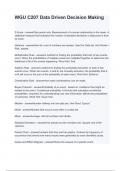-
1. Exam (elaborations) - Wgu c214 financial management oa study set and concept quiz all questions & answers s...
-
2. Exam (elaborations) - Wgu c214 oa financial management exam all questions & answers solved accurately with ...
-
3. Exam (elaborations) - Wgu c214 oa financial management retake exam all questions & answers solved accurate...
-
4. Exam (elaborations) - Wgu c214 concepts only multi choice version all questions & answers solved accurately...
-
5. Exam (elaborations) - Wgu c207 data driven decision making quiz all questions & answers solved accurately ...
-
6. Exam (elaborations) - Wgu c207 data driven decision making quizzes all questions & answers solved accuratel...
-
7. Exam (elaborations) - Wgu c207 data driven decision making all questions & answers solved accurately with c...
-
8. Exam (elaborations) - Wgu c207 data-driven decision making flashcards from course all questions & answers s...
-
9. Exam (elaborations) - Wgu c207 pre-assessment multi choice version data-driven decision making all question...
-
10. Exam (elaborations) - C207 wgu data driven decision making - all questions & answers solved accurately wit...
-
11. Exam (elaborations) - Wgu c211 - global economics for managers all questions & answers solved accurately wi...
-
12. Exam (elaborations) - Wgu c211 - global economics for managers all questions & answers solved accurately wi...
-
13. Exam (elaborations) - Wgu c211 global economics for managers (oa) exam all questions & answers solved accur...
-
14. Exam (elaborations) - Wgu c211 globalization (peng 1,5,6,11) all questions & answers solved accurately with...
-
15. Exam (elaborations) - Wgu c211 oa all questions & answers solved accurately with complete solution graded a...
-
16. Exam (elaborations) - Wgu c211 global economics for managers all questions & answers solved accurately with...
-
17. Exam (elaborations) - Wgu c211 oa global economics quizzes all questions & answers solved accurately with c...
-
18. Exam (elaborations) - Wgu c211 oa quizzes all questions & answers solved accurately with complete solution...
-
19. Exam (elaborations) - C 211 global economics for managers wgu pre assessment and retake all questions & ans...
-
20. Exam (elaborations) - C211 global economics for managers all questions & answers solved accurately with com...
-
21. Exam (elaborations) - Wgu c211 oa global economics exam all questions & answers solved accurately with comp...
-
22. Exam (elaborations) - C211 wgu oa exam all questions & answers solved accurately with complete solution gra...
-
23. Exam (elaborations) - Wgu c211 - global economics for managers - pa review all questions & answers solved a...
-
24. Exam (elaborations) - Wgu c211pre-assessment_ global economics for managers (uzc2) all questions & answers ...
-
25. Exam (elaborations) - Global economics - c211 pre assessment exam all questions & answers solved accurately...
-
26. Exam (elaborations) - Wgu c211 global economics terms all questions & answers solved accurately with comple...
-
27. Exam (elaborations) - Wgu c211 oa all questions & answers solved accurately with complete solution graded a...
-
28. Exam (elaborations) - Wgu c211 - global economics for managers all questions & answers solved accurately wi...
-
29. Exam (elaborations) - Wgu c211 global economics for managers 2024 with complete solution
-
30. Exam (elaborations) - Wgu c211 pre-assessment all questions & answers solved accurately with complete solut...
-
31. Exam (elaborations) - C213 accounting for decision makers-2 wgu all questions & answers solved accurately w...
-
32. Exam (elaborations) - Wgu c213 accounting all questions & answers solved accurately with complete solution...
-
33. Exam (elaborations) - C213 wgu oa prep all questions & answers solved accurately with complete solution gra...
-
34. Exam (elaborations) - Wgu c207 data driven decision making - data driven express cohort all questions & ans...
-
35. Exam (elaborations) - Wgu c213 accounting for decision makers abcd all questions & answers solved accuratel...
-
36. Exam (elaborations) - Wgu c213 accounting for decision makers pvac all questions & answers solved accuratel...
-
37. Exam (elaborations) - Wgu c213 accounting for decision makers all questions & answers solved accurately wit...
-
38. Exam (elaborations) - c213 accounting for decision makers -chapter 1, 2, 3, and 4 all questions & answers...
-
39. Exam (elaborations) - C213 accounting for decision makers - pre assessment all questions & answers solved ...
-
40. Exam (elaborations) - C213 wgu accounting for decision makers all questions & answers solved accurately wi...
-
41. Exam (elaborations) - Wgu c213 pre-assessment (accounting) all questions & answers solved accurately with c...
-
42. Exam (elaborations) - Wgu c213 study guide all questions & answers solved accurately with complete solution...
-
43. Exam (elaborations) - Wgu c213 topics 1-6 quizzes all questions & answers solved accurately with complete s...
-
44. Exam (elaborations) - Wgu c213. pre-assessment_ accounting for decision makers all questions & answers solv...
-
45. Exam (elaborations) - Wgu c213 all questions & answers solved accurately with complete solution graded a+ l...
-
46. Exam (elaborations) - Wgu c213 final exam all questions & answers solved accurately with complete solution ...
-
47. Exam (elaborations) - Wgu c213 oa prep all questions & answers solved accurately with complete solution gra...
-
48. Exam (elaborations) - Wgu c213 pre assessment all questions & answers solved accurately with complete solu...
-
Show more




